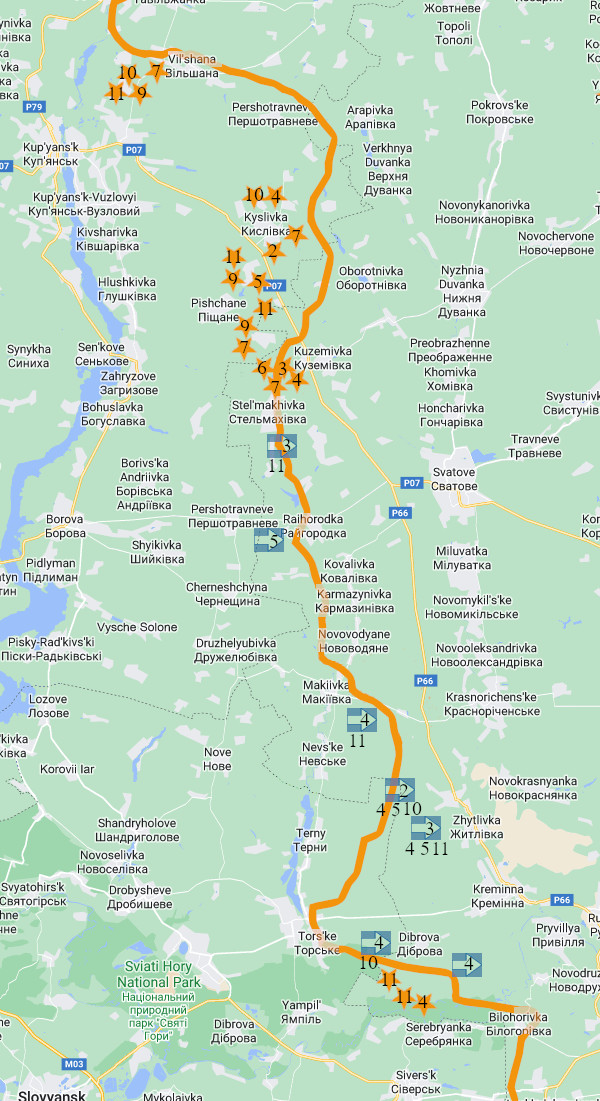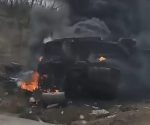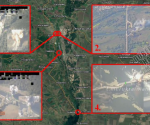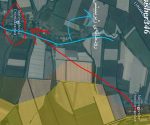Charted: Russian activity in the Kupyansk And Krasny Liman directions in December thus far
In the Russian Ministry of Defence daily briefings the action of its forces in the directions of Krasny Liman and Donetsk are explicitly called offensives.
So much for the starry host of big name geopolitical analysis and (universally controlled opposition) alternative media that keeps telling its audience that nothing is happening (except for a “meat grinder”, as the talking-point goes, at Artyomovsk). So much for the same charlatan class that is now embarrassing itself by back-peddling on its previous winking and hinting, and in the case of the bold, its declaring with certitude the prospect of a blood and thunder offensive to occur at the start of December (so that when it didn’t, audiences would see it as Russian weakness) and is now reverting to a nothing-is-happening-and-nothing-will position.
The Russian Ministry of Defence says that offensives are ongoing in the Krasny Liman and Donetsk directions.
Even so, it’s not as straight forward as that, and there is some misdirection going on. Towards this end, while the Russian MoD will lately make a statement like “[the offensive in the Krasny Liman direction has] resulted in the occupation of more favourable positions” – as it did on the 10th – there hasn’t been a change in its map since this site made a study of it on 2nd December.
Likewise, for a few days from 6th December onwards the Russian MoD gave no indication whatsoever as to where exactly the offensive in the Krasny Liman direction was happening – only that it was generally attracting (always failing) Ukrainian counter attacks. On 10th December, at last, some place names were given out to indicate vaguely where this might be happening.
The author suspects that another sort of misdirection is being deployed in respect of the Kupyansk direction in that the word “offensive” is being carefully omitted. The observation strongly suggests itself when one takes note of the actual language used to describe Russian activity in this section of the line and how it varies from that used to discuss Krasny Liman, and especially when one maps all of the activity in these directions.
In the chart below, the orange line is the front of the area of Russian control (as reckoned in the work mentioned above). Additionally, the icons represent reports about Russian activity made on the date in December indicated by the number (some of the arrows represent more than one report). The icons are placed in the general location of the activity as reported.
As can be seen, the reports can be classified in one of two ways. An arrow represents a report that details a Ukrainian movement towards Russian positions (some of these could be movement to forward defensive positions, even if the Russians indicate they are all Ukrainian [counter] attacks). This characteristic is evident in the description where the Ukrainians are turned back, or were attacked in the process of advancing, or themselves were said to be attacking with no further qualification offered.
An orange star appears to represent attacks on Ukrainian units as they are static in their positions, and again this can be discerned in the language where a supposed Ukrainian attack is being pre-empted, or more simply a concentration of Ukrainians is assaulted and disrupted. Perhaps one of the more revealing of these descriptions involves a company of Ukrainians being “hit by gunfire” near Tabayevka on 5th December, because it implies direct engagement between ground forces.
The fascinating thing about these classification sets is how, when they are mapped, they clearly illustrate different things going on in the Krasny Liman and Kupyansk directions. In the latter, the vast majority of Russian activity is shown to be offensive in that it is engaging static Ukrainians. In the former, the vast majority of Russian activity is said to be reaction to Ukrainian movement – but not Ukrainian initiative because they themselves are acting in response, or so the Russians say.
Indeed, for all the daily statements about their activity in the Krasny Liman direction being an “offensive”, from looking at the mapping of reports the author could well believe that it is in fact in the Kupyasnk direction where something like that is actually happening. Furthermore, it makes complete sense that the Russians would seek the eastern banks of the broad river Oskil as a more natural and defendable line to hold at the right flank of their operation to liberate Donetsk. Then, of course, there’s the question of what would happen to Ukrainian supply if Kupyansk and “Sen’kove” (as Google maps spells it) are captured (putting pressure on the third crossing further south along the river).
Incidentally, the casualty figures that the Russians have given for the Ukrainians as a result of the action mapped are as follows:
In the Krasny Liman direction: ~715 personnel, 5 tanks, 20 infantry (or “armoured”) fighting vehicles, 7 other armoured vehicles, 14 pickup trucks and 13 “motor vehicles”.
In the Kupyansk direction: ~540 personnel, 4 tanks, 13 infantry (or “armoured”) fighting vehicles, 2 other armoured vehicles, 12 pickup trucks, 4 armoured personnel carriers, and 16 “motor vehicles”. The Russians also make a point of singling out the destruction of a MT-LB (as Soviet armoured fighting vehicle from the 1950s) and two 2S-1 Gvozdika self-propelled artillery units (Soviet era weaponry from the ‘60s).
In summary, then, with a rate of Ukrainian casualty as generally high as it ever has been (see, for instance, the one reported in the article, Russian Gains And Ukrainian Losses In Donetsk, 1st September To 7th October), and with the Russians being coy in all sorts of ways about their exact doings, but yet demonstrating a distinct pattern of offensive activity, it is clearly not true to say of the Russian Special Military Operation that it is somehow frozen.
However, the very good reason that one will see alternative media in lockstep with what is actually a UK intelligence original is because Moscow didn’t “off-ramp” when London and Washington thought it would take the opportunity to do so after the world had been presented with a public relations version of events in Kharkov and Kherson involving an imagined Russian defeat. What actually happened in those regions – to cut a long story short – was that the Russians dealt with the Ukrainian “million man” army, and all the capability that the anti-Russian axis would ever have in terms of being a danger to territories that were once part of Ukraine and are now Russian. Ironically, at the same time that the Russians were allowing scope for this Western propaganda by repositioning from the northern (or western) side of the Dnipro river in Kherson, they were redeploying to positions by which to conduct offensives – as Surovikin, the General in charge of Russian forces in Ukraine, said himself (only to be ignored by the punditry and “expertise”). Leaving Kherson wasn’t about “off-ramping”, a point reinforced by the November strikes against Ukrainian energy and command infrastructure. It was also a move that demonstrated that the Russians couldn’t be demoralised, and Putin was in no danger of being overthrown by disgruntled oligarchs/ambitious politicians – the design for and hope of which has been the chief guiding principle and motivation of the US/UK’s conduct in Ukraine. As things stand, then, the anti-Russian axis is all out of tricks and bullets: it is a spent force. All it has left is the story that Russia can’t activate either, exploiting – as it always has in the conflict – the appearance that the Russian artillery warfare gives of being undynamic. Unfortunately, again as always, the Russian way of warfare has already carved out an inevitable outcome, and one that is being worked on a daily basis until the time there will be no way of hiding it.
Update, date as published, 17.oo:
Today in its briefing the Russian MoD has gone totally dark, and this is an important example to us because it is actually perhaps how we should expect a serious military to conduct itself in terms of the maintenance of operational security. When the Ukrainians were feeding the likes of Rybar blow-by-blow accounts of their charge into Russian guns in Kharkov, for instance, it was about achieving and enhancing the public relations impact.
The following amounts to all that the Russian MoD cares to reveal (that is most useful to us) today:
In Kupyansk and Krasny Liman directions, up to 70 Ukrainian servicemen, three armoured combat vehicles, and five vehicles were destroyed as a result of complex fire attacks against the areas where Ukrainian troops and military hardware are concentrated.
There’s a little bit more data about the activity of “Operational-Tactical Aviation, Missile Troops and Artillery”, of the sort that is regular in Russian briefings that isn’t really dwelt upon because it wouldn’t normally indicate much about front lines:
A Ukrainian Smerch multiple-launch rocket launcher was hit during a counter-battery firefight at a firing position near the village of Zeleny Gai (Kharkov region).
One Ukrainian combat vehicle for Uragan MRLS has been neutralised near Krasny Liman (Donetsk People’s Republic).
And then there is the also regular snippet about the day’s downing of Ukrainian aircraft, again which hasn’t usually been treated as being useful, but in actual fact perhaps needs some attention paid to it in the context of Russian advances, although none of these pique the author’s interest:
Six unmanned aerial vehicles were destroyed overnight near the villages of Golikovo, Ploshchanka [both in the vicinity of Zhytlivka], Melovatka [Miluvatka],… [and] Terny (Kharkov region) [close to the Russian border].
Update, 13th December:
While silence about Kupyansk continues, this – from the briefing of the date of update – is different:
In Krasny Liman direction, Russian artillery and heavy flamethrower systems foiled counterattacks by three assault groups of the Ukrainian Armed Forces from Terny and Yampolovka (Donetsk People’s Republic). The enemy’s casualties were more than 50 Ukrainian personnel killed or injured, two infantry fighting vehicles, an armoured vehicle, and three pickup trucks.
Yampolovka is in the conurbation on the banks of the body of water north of “Tors’ke” to the south of Terny.




















How many square meters does an artillery shell blow up when it hits its target? I read “10 million Russian shellls” had supposedly been fired. That is 10 million square meters of damage at only 1m2 per shell. A British or US source was quoted for the 10 Million shells fired in the Telegraph or FT.
I was wondering what your opinion of this was?